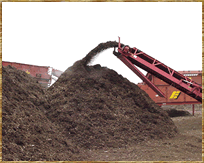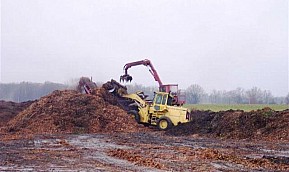December 17, 2013
Background
The Northeast Indiana Solid Waste Management District (NISWMD) was formed in 1990 through an interlocal agreement. It is comprised of four predominantly rural counties. The District works with its member counties, DeKalb, LaGrange, Noble and Steuben, to provide services to 154,683 residents. The counties cover 1,468 square land miles, with a population that is 61% rural and 39% urban.
Through a system of staffed drop-off centers, the District provides a comprehensive approach for managing and processing yard trimmings and brush, bringing economies of scale to benefit its member counties and residents.
Planning and Program Description
 The District uses a system of staffed drop-off centers for the collection of yard trimmings, including leaves, brush and grass clippings. Five yard waste composting facilities are operated by the District: Kendallville (population 9,862) and Ligonier (population 4,405) in Noble County; LaGrange, the county seat of LaGrange County (population 2,625); and one each in DeKalb and Steuben Counties (in unincorporated areas).
The District uses a system of staffed drop-off centers for the collection of yard trimmings, including leaves, brush and grass clippings. Five yard waste composting facilities are operated by the District: Kendallville (population 9,862) and Ligonier (population 4,405) in Noble County; LaGrange, the county seat of LaGrange County (population 2,625); and one each in DeKalb and Steuben Counties (in unincorporated areas).
Organic materials are dropped off in designated locations at the facilities. Residents are asked to keep grass and leaves separate from brush (tree limbs and shrubs). Leaves collected by municipalities within the District are also brought to the composting facilities for processing. As a part of its yard waste management program, the District owns two leaf vacuum trucks which it makes available at no cost to municipalities throughout DeKalb, LaGrange, Noble, and Steuben counties.
District personnel manage the grass and leaves by mixing the materials with a front loader and forming materials into windrows. A windrow turner is used to periodically turn the windrowed materials over a period of several months. Each site has a front loader. The District’s windrow turner is transported from site-to-site as needed to mix and turn materials. Materials are monitored for stability and cured onsite. The finished compost is screened to remove any contaminants and create a high demand compost product. The screener is also moved from site-to-site, depending on need.
Compost is available seasonally and can be purchased for $5.00 a cubic yard. An operator is onsite to load vehicles.
Brush is ground with the District’s tub grinder into a wood mulch product. All material is natural, no coloring added, and one-inch in size or under. In 2008, the District obtained certification from the Indiana Department of Natural Resources for its mulching operation. The certification verifies that mulch from the compost programs is safe to transport without risk of transmitting the emerald ash borer species.
All yard waste facilities are open from mid-April through mid-November and after the holiday season for Christmas tree disposal. Finished compost and wood mulch can be picked up at any of the compost sites operated by the District, allowing customers access to a type of “one-stop” opportunity for discarding yard trimmings and picking up compost and mulch.
Cost/Funding
The program is funded through the District’s general operating budget. District funding is from the property tax base. The District receives one cent per $100 assessed valuation of property. The program costs for 2011 were approximately $25/ton. Over the years, costs have varied from $22 to $44/ton depending on the number of tons processed per year.
There is no charge for residents or municipalities to bring yard trimmings to the compost facilities. Funds from the sale of compost are used to subsidize the program.
Equipment and Collection
 In most cases, the District provides labor, equipment and funds for the program and member counties provide the property for the yard waste compost facilities. The District owns two leaf vacuum units which are available on a first come first served basis to all municipalities throughout DeKalb, LaGrange, Noble, and Steuben counties.
In most cases, the District provides labor, equipment and funds for the program and member counties provide the property for the yard waste compost facilities. The District owns two leaf vacuum units which are available on a first come first served basis to all municipalities throughout DeKalb, LaGrange, Noble, and Steuben counties.
The District has policy guidelines for use of the leaf vacuum units, including the requirement that municipalities provide their own one-ton or larger truck to pull the unit, along with a hook-up, and towns must provide the fuel for operation.
The District owns five front loaders (one for each composting facility) for mixing organics for composting and loading finished compost. A District-owned windrow turner is used for managing the organics for compost. The windrow turner is transported to each composting facility, as needed.
The District has a tub grinder for grinding mulch, as well as a screener for screening finished compost. Both pieces of equipment are transported to the composting yards as necessary.
Results & Impacts
- In 2011, the District diverted approximately 19,000 tons from the solid waste stream resulting in a 9.5% diversion rate.
- A total of 28,200 (resident) vehicles participated in the program in 2011.
- Compost has proven to be a high demand product for District residents.
- Regional cooperation, with the District providing labor, equipment and funds for the program and member counties providing property for the compost facilities has worked effectively to divert yard trimmings from the waste stream.
Lessons Learned
- A regional cooperative approach works well for rural jurisdictions, especially in recycling and more specifically yard waste composting.
- Staffed facilities and operations are much preferred and much less problematic than an unstaffed situation.
- Always charge a fee – even if it’s just a dollar. It provides the basis to address future operational costs. A fee also is an education tool providing the basis to teach basic material handling facts such as that recycling is not free and the first rule of environmental science – “there is no such thing as a free lunch.”
- If it’s a choice between new equipment and a well-qualified mechanic, choose the mechanic. Leverage state and federal surplus programs for material handling equipment, such as wheeled front-end loaders. Operations do not need to load mulch or compost with a new machine, but a well-maintained loader does need to be onsite to keep material going out.
Conclusion
The Northeast Indiana Solid Waste Management District and its four member counties present a model for regional cooperation that allows for economies of scale to effectively manage yard trimmings and brush.
The District’s leaf vacuum equipment loan program assists municipalities in their ability to collect leaves from their residents. The location of a composting facility in each county provides for easy drop-off access for municipalities and residents.
Onsite management of yard trimmings and brush chipping provides local residents with low-cost finished compost product for use in yards and gardens, along with free wood mulch. The District benefits from manufacturing value-added quality products that can be sold to offset the costs of their organics management program.
Click on Northeast Indiana Solid Waste Management District to see the full case study on NERC’s website.
By Athena Lee Bradley


Comments (0)
Add a Comment